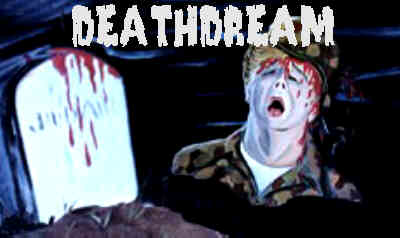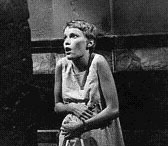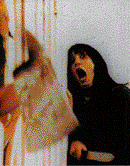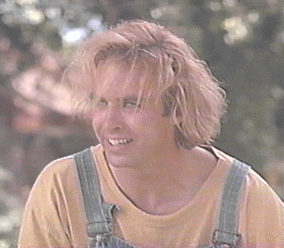|


i. porky’s 3: the quickening
I
was watching Bob Clark’s drive-in masterpiece Deathdream
(1972) with some friends and I noticed they were cringing
because the actors weren’t, um, exhibiting the subtleties
of their craft, shall we say. I tried to insert other stars
into the film like reverse paper dolls -- replacing the
faces and bodies under the outfits. And pretty soon I had
Jessica Lange, Dustin Hoffman and Chloe Sevigny acting out
Clark’s Vietnam-era Freudian nightmare.
Here’s the back story before I
bring our fine, academy-approved thespians into these low
budget environs. Bob Clark (much later of Porky’s fame)
and Alan Ormsby (later screenwriter for 1982’s Cat People
and Karate Kid III) concocted the most delirious
and unjustly ignored horror films of the early/mid-70s:
Deranged (1974), Children Shouldn’t Play with Dead
Things (1972), Deathdream and Black Christmas
(1974). Deathdream is about a young man’s homecoming
from Vietnam and the potential hideousness of a mother’s
love. It’s better than The Deer Hunter and Coming
Home where Vietnam is concerned and much better than
Robert Redford’s Ordinary People Mom-wise, but it’s
also a horror movie so nobody gives a shit.
We first see the soldier’s family
sitting around the supper table. The perfect little family
but something’s off. The mother has her head tilted like
a little bird, her face a mask of Valium calm as she rambles
on about her son, Andy, and how nobody on her daily route
of wifery can wait for him to come home. She just chirps
and chirps and the father and the daughter barely contain
a series of twitches and tics that tell us all is not right
with their little carpenter’s gothic world.
The doorbell rings and the
first of many haunted shots bathed in front porch light
ensues. A local ROTC officer brings the family word that
their son, Andy, died in combat. Of course, this completely
shatters the scene and some kind of animal order takes hold
in the house, something much older than 1972. The mother
makes some  kind
of pact with the dark woman/mother forces by candle light
and that very night Andy returns home. kind
of pact with the dark woman/mother forces by candle light
and that very night Andy returns home.
The family immediately begins whitewashing their hopeful
expectations all over him while he remains quiet, unblinking,
unfamiliar with his own body. This is glorious, they tell
him. He can resume his sunny youth. There’s dating to be
done. Wait until the neighborhood sees how great he looks
in his uniform. Andy, can you believe, they ask him, can
you believe they said you were dead?
I was, Andy answers. Dad looks
at Andy like his boy’s a busted appliance. Daughter looks
at Mom like she’s a story problem. Mom looks like she’s
trying out for a 60s Anacin commercial. Andy looks at Mom
like they’re in cahoots. Then Andy’s face cracks open to
reveal… what? Like baby teeth, teeth with just a little
too much space between each one, gums that are too pink,
and what’s that sound he’s making? Well, it’s a laugh I
guess, but it seems to come from a ventriloquist hidden
off screen. The laugh doesn’t stir his body, which remains
perfectly immobile, one hand caught like a spider in the
lace tablecloth, the other limp in his lap. Still, the family
takes what it can get and soon they’re all laughing with
high-strung warmth.
Of course, Andy’s dead. It’s the
old Monkey’s Paw story retold with counter culture
vigor. By the autumnal, muted colors of the porch light,
the family unravels slowly. Andy just sits in his old room
in the dark, rocking back and forth in a chair. He’s surrounded
by boyhood clarity (a Scooby Doo light switch, some cowboy
toys) but he’s just more bric-a-brac now. To the family
anxiously awaiting a return to normalcy below him, the rocking
begins to sound like a tell-tale heart.
In a day or two, they draw Andy
(Richard Backus, who’s sad and terrifying and apparently
never acted again) into the backyard for a picnic where
all the young kids from the neighborhood descend upon him
to quiz him on his heroism. In a fine exhibition of what
military service has made of him, he strangles the family
dog before their eyes.
This sends Dad to the local bar
and then back home where he hopes to confront Andy. No Andy,
just an empty rocking chair. Dad stumbles down the stairs
to see where his pet-strangling war hero son’s gone:
Daughter: (Hearing her father slamming around in
Andy’s room) Daddy? Daddy?
Father: (Seeing a car
pull out of the driveway) Is that Andy?
Daughter: Yes, Daddy. He
went out the back door. Mother gave him the keys.
Father: (Calling out
to his wife) Christine! Christine!
(Mom appears)
You let him go!!??
Mother: Why not? I’d leave
too if my father came home drunk.
Daughter: Daddy? What’s
the matter?
Father: (Shoving her
aside) Oh, mind your own goddamn business!
John Marley, the film producer who wakes up to find his
prize race horse’s head among the folds of his satin sheets
in The Godfather, plays Dad as a befuddled sleep
walker through the middle class until his only son returns
from Vietnam a blood drinking ghoul. Lynn Carlin,
who plays the Mom, is perfect. Underneath a gauze of pain
pills, muscle relaxants and tranquilizers there’s this coyote
mother who must protect her little pup at all costs. And
little sister is just a teeny-bop cipher, humming along
on an oblivious teenage track that just took a detour to
some dark cave where coyote mothers and ineffectual, drunken
fathers hunch down in darkness until this unexpected flurry
of evil spirits passes by. Sis is an accessory and one Mom
is willing to jettison to protect her darling walking corpse.
The acting by all three leads is so emotionally jagged and
just plain off that the movie never lets you settle in to
its rhythms. We are never offered melodrama as a substitute
for discomfort.
It’s a crazed scene of family dysfunction
and when you insert Lange, Hoffman and Sevigny (or any other
Hollywood A-list threesome), it simply doesn’t work. Why?
Because perfect horror acting is pitched at either hysteria
or catatonia. Pitch a performance somewhere in between,
the realm where most Hollywood actors find Oscars and critical
acclaim, and the whole scene collapses. Most mainstream
Hollywood acting is about rhythms, keeping things on the
beat is essential. Occasionally a scene will change up the
timpani beats for rimshots, but rarely does a whole movie
work off-the-beat. It simply isn’t done. Except in horror
films or, for that matter, exploitation films in general.
Here the rhythms are always off and to great effect. Even
teen slasher films which give you a cadence as predictable
as a Casio drum sample, usually (the Scream series
being an exception and a horror novelty at best) benefit
from strange performances: Crispin Glover in Friday
the 13th – The Final Chapter (Joseph Zito, 1984),
John Saxon and Ronne Blakely in Nightmare on Elm Street
(Wes Craven, 1984), etc. Though the technical rhythms
(editing, lighting, music) of these genre exercises are
etched in stone and delivered with stone age pragmatism,
performances like these keep us from engaging completely.
Only in genre exercises is this essential. In a mainstream
Hollywood product, the audience has to be engaged, often
before the opening credits are through. In horror and exploitation,
it’s either the blank or the dervish. In between is inconsequential.
"Bad" acting enhances delirium, feverishness and horror’s
powerful arrhythmia.
ii. waldorf
salad and other just desserts
In the
last twenty years Hollywood has been trying to weld B-movie
thrills onto A-movie sheen and it rarely works. I suppose
it all started with Rosemary’s Baby (1968). Here
we have a pulp novel by Ira Levin, produced by the king
of B-movie thrills, William Castle, and directed by Eurostentialist
Roman Polanski. Mia Farrow and John  Cassavetes
share lead billing and, to their credit, their method chops
pretty much lead them just shy of catatonic. In fact, most
of the cast, good, evil and otherwise, play the script jaded,
like they’re saying, "so it’s the devil in the Big Apple,
what else ya got?" It’s a fine ruse and it keeps the stars
from "peeling away layers" and "finding motivations".
Even the final Satanic coffee clatch is played like brunch
at the Waldorf: "Hail, Satan," they lift their goblets and
chant with all the conviction of conventioners toasting
sprockets and sales figures. Cassavetes
share lead billing and, to their credit, their method chops
pretty much lead them just shy of catatonic. In fact, most
of the cast, good, evil and otherwise, play the script jaded,
like they’re saying, "so it’s the devil in the Big Apple,
what else ya got?" It’s a fine ruse and it keeps the stars
from "peeling away layers" and "finding motivations".
Even the final Satanic coffee clatch is played like brunch
at the Waldorf: "Hail, Satan," they lift their goblets and
chant with all the conviction of conventioners toasting
sprockets and sales figures.
William Friedkin’s The Exorcist
(1973) played it straighter and suffered for it. The stars,
especially Max Von Sydow and Ellen Burstyn, are ridiculous,
trying vainly to get at some of William Peter Blatty’s spiritual
subtext while nearly drowning in green spew. Only Jason
Miller, as the priest who’s lost his faith, and Linda Blair
who, God knows, can find her way around a B-flick, really
shine in this cast. Miller is a slightly more controlled
version of Jeffrey Combs, one of the great horror actors
of the 80s and 90s. Combs can play madness on hold (the
mad scientist in Stuart Gordon’s Re-animator), madness
brewing (the terrified scientist in Gordon’s From
Beyond), and madness de Mille (the totally unhinged
cult expert in Peter Jackson’s The Frighteners).
But it’s all madness and you’re not going to see him standing
next to Robert Zemeckis this March at the Oscars or even
next to David E. Kelly at the Emmys. He’s a creature made
for B-movies and hell, he doesn’t invade Harrison Ford’s
territory, why should Ford invade his?
The Shining (1980), a prestige
picture directed by American expatriate Stanley Kubrick,
further blurred the line between mainstream cinema and exploitation
crud. The Shining’s an odd bird because, while it’s
a prestige picture, the performances are B-movie heaven.
Of course Jack Nicholson, to this day, can run amok through
hamdom like he never left the Roger Corman stables at AIP,
but in this movie he doesn’t even try to contain himself.
And this after prostrating himself before Oscar
 several
times during the 70s. He’s all over the place and the critics
savaged him while horror and exploitation fans reclaimed
an old idol. several
times during the 70s. He’s all over the place and the critics
savaged him while horror and exploitation fans reclaimed
an old idol.
The real star of The
Shining however, is Shelley Duvall with her stringy
hair, pop eyes and horse teeth. Why she hasn’t found a permanent
and lucrative home in horror films is beyond me. Maybe it’s
because Robert Altman and other arty directors keep telling
her she’s a star. Let her go hang out with Stuart Gordon.
She’ll have fun. She and Jeffrey Combs can chase each other
around the laboratory with iridescent zombie elixir.
iii.
gandhi and the aliens
After
The Shining, the real trouble started. Perfectly
serviceable horror and sci-fi movies were ruined by "layered"
performances. Great, juicy crap like Species, Mimic,
Wolf (featuring a sadly restrained Nicholson and
a ludicrous Michelle Pfeiffer), The Sixth Sense,
The Haunting of Hill House and What Lies Beneath
(more ludicrous Pfeiffer) were totaled by good acting.
What are Ben Kingsley, Forest Whitaker, Marg Helgenberger
and Alfred Molina doing in Species, a potentially
rip-roaring, sexy alien movie sunk by star power. What’s
Mira Sorvino doing in Mimic? What are Lili Taylor
(really overthinking sexual ambiguity) and Liam Neeson (really
underestimating his  cache)
doing in The Haunting of Hill House? What’s Harrison
Ford doing….well, what is Harrison Ford doing? These films
cry out for Combs, Bruce Campbell, Brad Dourif, Harry Dean
Stanton, Shelley Duvall, Michael Madsen (who is in Species
and tries hard to salvage it), Billy Zane, Jeff Fahey, Geoffrey
Lewis and other ding dongs whose specialty is going from
limp to BINGO! in a blink. cache)
doing in The Haunting of Hill House? What’s Harrison
Ford doing….well, what is Harrison Ford doing? These films
cry out for Combs, Bruce Campbell, Brad Dourif, Harry Dean
Stanton, Shelley Duvall, Michael Madsen (who is in Species
and tries hard to salvage it), Billy Zane, Jeff Fahey, Geoffrey
Lewis and other ding dongs whose specialty is going from
limp to BINGO! in a blink.
iv.
you’re not the man i married
When I was a kid I watched the Saturday night Creature Feature
religiously. I saw a million movies that scared the
hell out of me back then, but the one I remember most fondly
is I Married a Monster from Outer Space (Gene Fowler,
1958). In it, Tom Tryon (now Thomas Tryon and author of
the spooky bestseller, The Other) plays Gloria Talbot’s
brand new husband. On their wedding night, Tom is possessed
by an alien monster that makes him act indifferently toward
his new bride. In fact, he skulks through the house like
a determined ghost while Gloria thinks she may have done
something wrong. After all, this is her first marriage,
maybe she missed something in the instruction manual. This
isn’t the man I married just a few hours ago, she thinks
to herself. But hey, no one said marriage was a walk in
the park, maybe this is just the way it is once the bloom’s
off the rose. Tom Tryon is terrifying in this film just
by being boring and blank and dissociated. In my kid mind,
he was the greatest horror actor I’d ever seen.
Years later, I saw Tryon in Otto
Preminger’s big budget snooze The Cardinal (1963)
and in Dalton Trumbo’s Johnny Got His Gun (1971)
and damned if he wasn’t just as terrifying. Hell, he was
the same character – boring, blank, dissociated. Trouble
was, the film had changed up on him, apparently without
him noticing.
In the three or four moments in
my life when I’ve viewed people in extremis, people barely
hanging onto sanity or who’ve actually become raving things,
they’ve behaved far more like the characters in Deathdream
and Deranged and I Married a Monster from Outer
Space than the A-list actors who inhabit Robert Redford’s
Ordinary People or that New Age fraud, The Sixth
Sense. In fact, for most of the the late 60s my family
was held fast in the thrall of suburban malaise, alcoholism,
the war, adultery, tranquilizers and mental illness. They
became, in essence, unfamiliar with their roles, method
actors untethered from their stock leads. My Dad became
Tom Tryon and my Mom behaved very much like Andy’s mother
in Deathdream. My God, what performances..
(Note:
This column is named for a misunderstanding. While looking
up the film credits for the British director Charles Crichton,
I came upon this entry: Things to Come, Elephant
Boy (1936). For just a moment I imagined what this great
lost picture might look like and then I realized Crichton
had worked on two films that year, Things to Come
and, later, Elephant Boy. Still, I’d like to write
a script someday for this optimistic, wistful and brazenly
exotic science fiction film, starring Sabu and Maria Montez.)
-- Charles Lieurance, October 2000
|